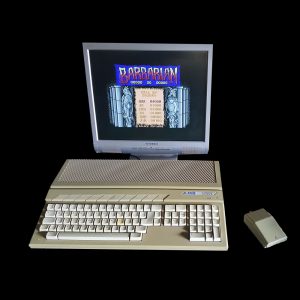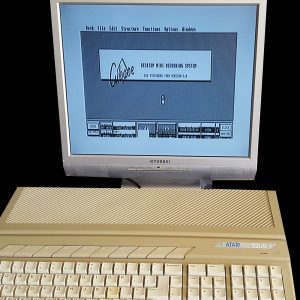
Atari ST520fm
Posted by musovern on Apr 13th, 2018 in Atari, Vintage Computers | 0 comments
The 520ST was an all-in-one unit, similar to earlier home computers like the Commodore 64. By the time the 520ST reached the market, however, consumers demanded a keyboard with cursor keys and a numeric keypad. For this reason, the 520ST was a fairly large and awkward computer console.
Adding to this problem was the number of large cables needed to connect to the peripherals. This problem was addressed to some degree in the follow-on models which included a built-in floppy disk, though this addition resulted in the awkward placement of the mouse and joystick ports to a cramped niche underneath the keyboard.
Early 520ST owners became accustomed to the “Atari Twist” and the “Atari Drop” service procedures. “Atari Twist” seemed to help discharge built-up static electricity (Atari soldered-down the metal shielding to fix the problem) while the “Atari Drop” appeared to help re-seat chips which may have become partially unseated over time.
The case design was created by Ira Valenski – Atari’s chief Industrial Designer. The ST was basically wedge shaped, with a series of grilles cut into the rear for airflow. The majority of the machines had keyboards with soft tactile feedback resulting in a “cheap” feel, with rhomboid function keys across the top edge. The original 520ST design used an external floppy drive; the 1040ST-style case featured a built-in floppy drive. The power supply for the early 520ST was a large external brick while the 1040ST’s was inside the machine.
Specification of the 520st:
CPU: Motorola 68000 @ 8 MHz. 16-bit data/24-bit address bus. RAM: 512 KB or 1 Megabyte, Display modes (60 Hz NTSC, 50 Hz PAL, 71.2 Hz monochrome):
Low resolution – 320×200 (16 color), palette of 512 colors , Medium resolution – 640×200 (4 color), palette of 512 colors, High resolution – 640×400 (mono), monochrome
Sound: Yamaha YM2149 3-voice squarewave plus 1-voice white noise mono Programmable Sound Generator
Drive: Single-sided 3½” floppy disk drive, 360 KB capacity when formatted to standard 9 sector, 80 track layout.
Ports: TV out (on ST-M and ST-FM models, NTSC or PAL standard RF modulated), MIDI in/out (with ‘out-thru’), RS-232 serial, Centronics parallel (printer), monitor (RGB or Composite Video colour and mono, 13-pin DIN), extra disk drive port (15-pin DIN), DMA port (ACSI port, Atari Computer System Interface) for hard disks and Atari Laser Printer (sharing RAM with computer system), joystick and mouse ports (9-pin MSX standard)
Operating System TOS v1.00 (The Operating System) with the Graphical Environment Manager (GEM) WiMP (Windows, Mouse, Pointer) GUI.
Manufacturer: Atari
Date: 1985
My unit running Cubase Audio software

Leave a Reply